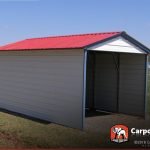When it comes to adding a covered terrace to your home, the possibilities for materials are almost endless and there are so many different factors to take into account when choosing which material is best for your needs and budget, from the maintenance that each surface requires to the visual impact on your home. Here we look at some of the most popular materials for creating a terrace cover, as well as their pros and cons. Each section compares one material against another in order to help you make an informed decision about which is right for you.
Steel Terrace Covers
Steel terrace covers can be made from a variety of different materials. In general, the steel is just used as a framework onto which other materials are attached. This makes it a very versatile material, as it can be used both as a covering and as a support frame.
A good advantage of steel is durable and long-lasting, making it the perfect material for exposed areas. Moreover it withstands all types of weather, including heavy winds and snow loads. To add to that you can choose from a variety of different finishes, from black powder-coated steel to brushed stainless steel, to create the perfect look for your home.
However, steel is more costly than other materials. It may also not be as aesthetically pleasing as other materials such as glass.
PVC Terrace Covers
PVC is one of the most common materials used for terrace coverings. It’s a type of plastic that’s been treated with UV inhibitors to prevent it from deteriorating in direct sunlight.
Some of the advantages of PVC is it needs low maintenance, resistant to rot and decay and requires very little upkeep. PVC is also lightweight, making it easy to install and transport.
However, PVC is not weatherproof. The plastic can become brittle in cold weather, and it doesn’t hold up as well against snow loads. Infact, PVC also become slippery when wet, making it less safe than other materials, such as wood.
Timber Terrace Covers
Timber is a natural, beautiful material that has been used to cover outdoor areas for centuries. It comes in many different types and boasts a variety of different finishes, such as stain, varnish and oil, which can be mixed and matched to help you create the perfect look for your home.
Some of the timber pros is that when done well it is very attractive that suits most home styles. It’s also very sturdy and can hold up to extreme weather, even in coastal regions. Timber is available in a wide range of grades and thicknesses, so you can choose what best suits your needs.
However, timber is not completely maintenance free. You’ll need to oil or stain it regularly to protect it from the elements and prevent it from drying out.
Brick Terrace Covers
Brick is a classic material that can help you create a terrace cover that blends seamlessly into your home.
Some of its pros, bricks are durable material that will last for decades if properly maintained.
However, Bricks can be very expensive and heavy to transport, making it more costly than some other materials.
Concrete Terrace Covers
Concrete is a very strong and durable material that is often used as a ground covering. You can create a terrace cover from concrete by laying a thick layer of the material over the ground, then adding a wooden decking or pavers on top.
Pros
Concrete is a very sturdy, cost-effective and durable material that can support heavy loads, making it great for outdoor use. It also comes in a variety of different colors, so you can choose the best one for your home. Concrete is also very cost-effective, making it a great choice for those on a budget.
Cons
Concrete can be extremely heavy and difficult to work with, making it unsuitable for smaller gardens. It also requires regular maintenance, such as resealing and re-pointing, to ensure it lasts as long as possible.
Conclusion
There are a variety of different materials you can choose when creating a terrace cover. We’ve looked at some of the most popular materials and compared their pros and cons. Hopefully, you now have a better idea of what each material is best used for and which one might be right for you.









